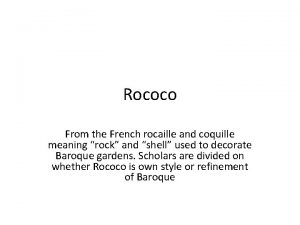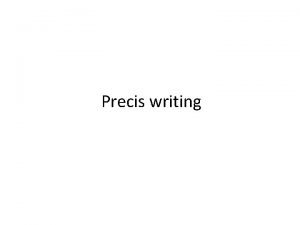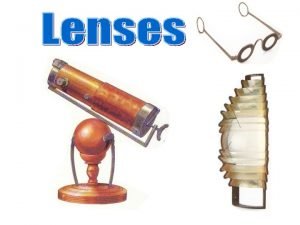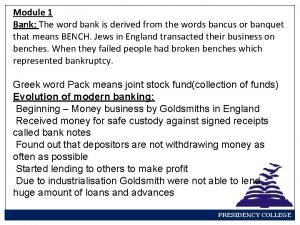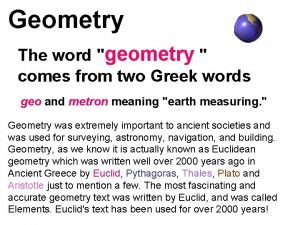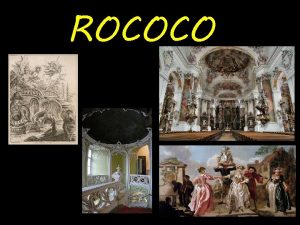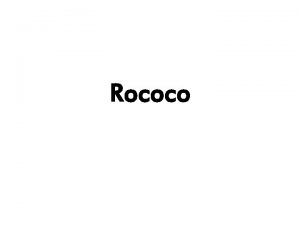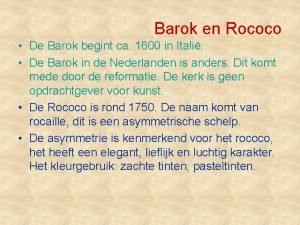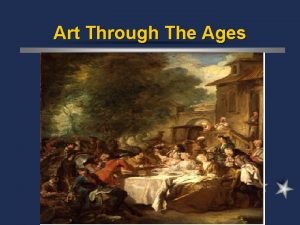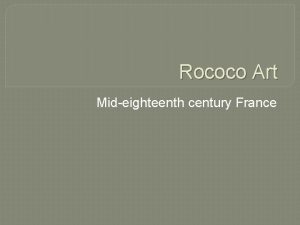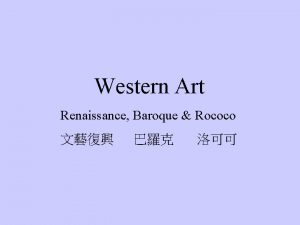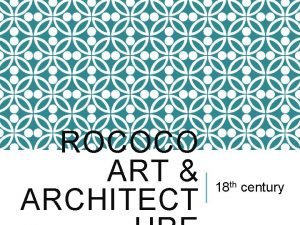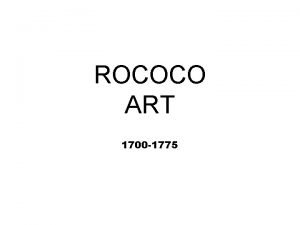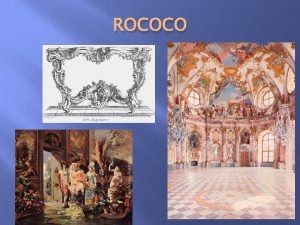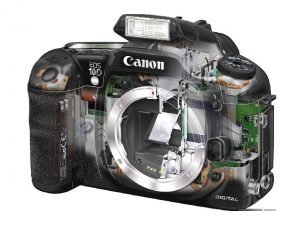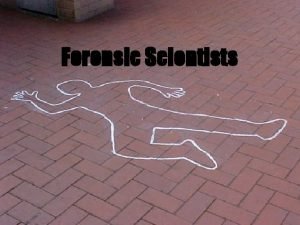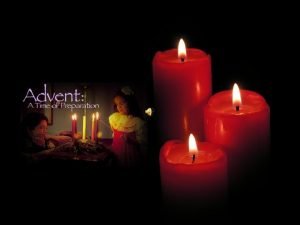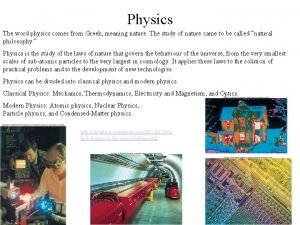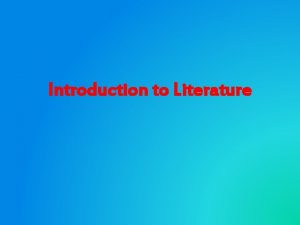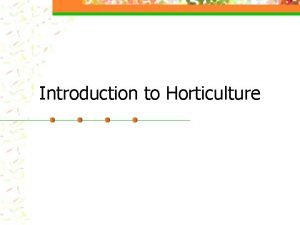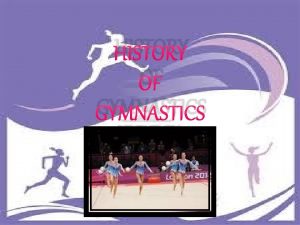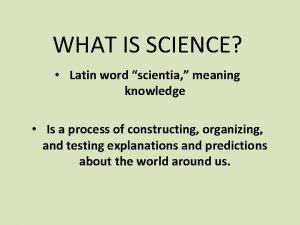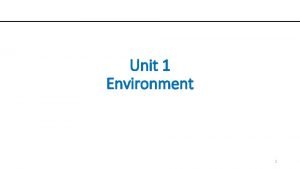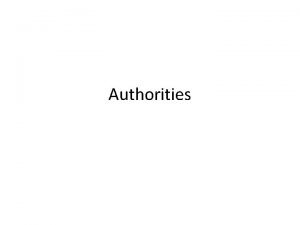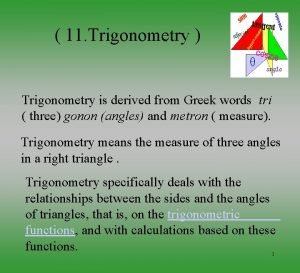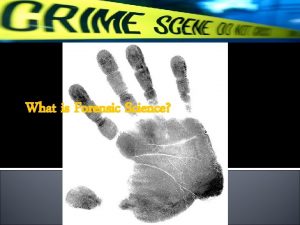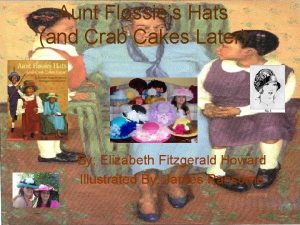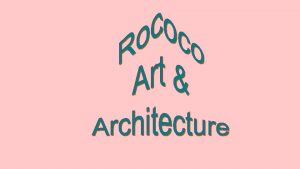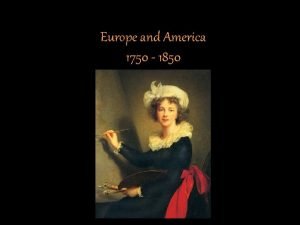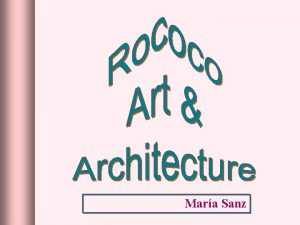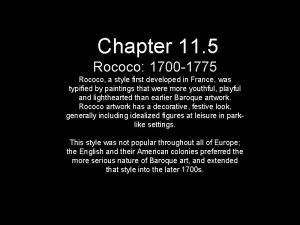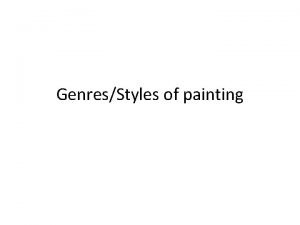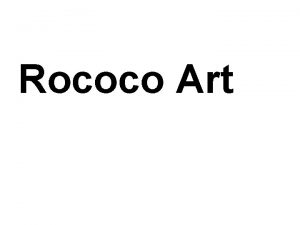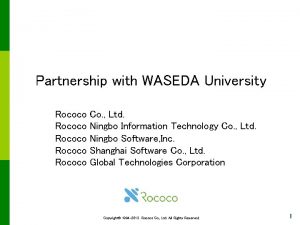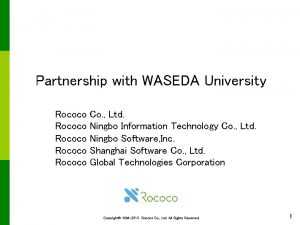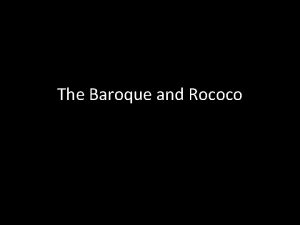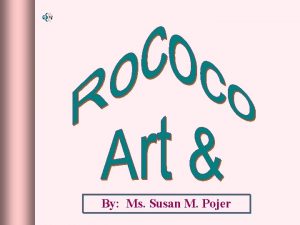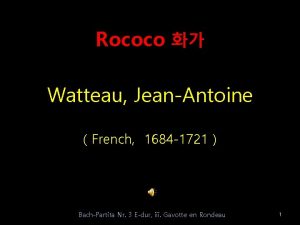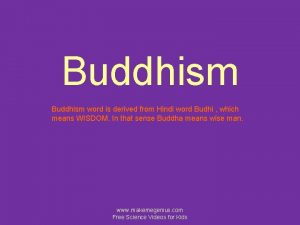Derived Rococo from the French word rocaille or







































![John Wood “The Royal Crescent [Circus]” at Bath, England (1754). John Wood “The Royal Crescent [Circus]” at Bath, England (1754).](https://slidetodoc.com/presentation_image/5da4ea8680b2339ee77c6d88644087d8/image-40.jpg)


































- Slides: 74


► Derived Rococo from the French word, rocaille or pebbles, referring to the stones & shells used to Rococo style “dances. ” Portrays the carefree life of the aristocracy -- landscapes like fairy tales. decorate the interior of caves. ► ► Complex compositions. ► Ornateness and fussy details. ► Gaiety, lightness, and airyness

Rococo ► 1715 – 1774. ► Centered in France --> associated with Louis XV. [also Germany and Italy] ► Light, elaborate, decorative style. ► Pastels. ► A backlash to the darkness of the Baroque --> less formal & grandiose. ► Eventually replaced by Neo-Classicism, the artistic style of the American & French Revolutions.

“The Marriage Contract” Jean-Antoine Watteau, 1713

“The French Theater” Jean-Antoine Watteau, 1714

“The Pleasures of the Ball” Jean-Antoine Watteau, 1717

“The Pleasures of Life” Jean-Antoine Watteau, 1718

“The Swing” Jean Honoré Fragonard 1766

“The Stolen Kiss” Jean Honoré Fragonard Late 1780 s

“A Young Girl Reading” Jean Honoré Fragonard 1776

“The Triumph of Venus” François Boucher 1740

“La Toilette” – François Boucher, 1742

“The Marquis de Pompadour” François Boucher 1756

“Morning Coffee” François Boucher 1739

“The House of Cards” Jean Siméon Chardin 1735

“Winter” Etienne. Maurice Falconet 1771

“The Rape of Europa” Giovanni Domenico Ferretti, 1720 -40


“Colonel St. Leger” Sir Joshua Reynolds 1778

“The Children of Edward Holland Cruttenden” Sir Joshua Reynolds

“Mr. & Mrs. Andrews” Thomas Gainsborough, 1750

“Portrait of a Lady in Blue” Thomas Gainsborough Late 1770 s

“Mary, Countess Howe” Thomas Gainsborough Late 1760


A Rococo Room

Wall Clock “Love Conquering Time” Charles Cressent 1740

“Fire Dog” François. Thomas Germain 1757


Overview of Neo-Classicism $ Art produced in Europe and North America from the mid-18 c to the early 19 c. $ More than just an antique revival a reaction against the surviving Baroque & Rococo styles. $ Linked to contemporary political events: S Revolutions established republics in France and in America. [Neo-Classicism was adapted as the official art style]. S Association with the democracy of Greece and the republicanism of Rome. S Napoleon used the style for propaganda.


1. Excavations of the Ruins of Italian Cities Pompeii in 1748. Herculaneum in 1738.

2. Publication of Books on Antiquity James Stuart & Nicholas Revert Antiquities in Athens: 1762 -1816.

3. Arrival of the Elgin Marbles Thomas Bruce, 7 th Lord of Elgin British Museum, 1806 From the top façade of the Parthenon in Athens.

4. Johann Winckelmann’s Artists Circle German art historian. $ Artists should “imitate” the timeless, ideal forms of the classical world. $ A circle of international artists gathered about him in the 1760 s in Rome.

Characteristics of Neo-Classicism $ Return to the perceived “purity” of the arts of Rome. $ Model the “ideal” of the ancient Greek arts and, to a lesser, extent, 16 c Renaissance classicism. $ A conviction that there is a permanent, universal way things are (and should be), which obviously entails fundamental political and ethical commitments. $ Sometimes considered anti-modern or even reactionary.


Robert Adam Syon House The Red Salon Scottish architect & designer Syon House 1760 s

Claude Nicholas Ledoux $ Designed a pavilion in 1771 for the Comtesse du Barry at Louveciennes. $ Designed a series of city gates for Paris (1785 -1789).

Claude Nicholas Ledoux Rotunde de la Villette, Paris
![John Wood The Royal Crescent Circus at Bath England 1754 John Wood “The Royal Crescent [Circus]” at Bath, England (1754).](https://slidetodoc.com/presentation_image/5da4ea8680b2339ee77c6d88644087d8/image-40.jpg)
John Wood “The Royal Crescent [Circus]” at Bath, England (1754).

The “Empire Style”: Charles Percier & Pierre François Léonard Fontaine $ Napoleon’s official architects. $ They remade Paris in the intimidating opulence of Roman imperial architectural style.

Greek-Inspired Architecture Bank of England Rotunda Sir John Soane, 1796 British Museum Portico Sir Robert Smirke, 1823 -1847

The “Federal Style” in America $ 1780 – 1820. $ Thomas Jefferson’s influence. University of VA Monticello, VA U. S. Capitol

The “Greek Revival Style” in America Second Bank of the US Philadelphia, 1824


“Parnassus” Anton Raphael Mengs, 1761 Mengs was the leading artist of early Neo-Classicism.

“The Oath of Brutus” Gavin Hamilton, 1767 The oath was sworn as a promise of individual revenge against a corrupt monarchy.

“The Death of Socrates” Jacques-Louis David, 1787 The death of Socrates was a symbol of republican virtue.

“The Consecration of Napoleon & Josephine” Jacques-Louis David, 1805 -1807 A very different theme: The celebration of worldly splendor and power.

“The Apotheosis of Homer” Jean-Auguste-Dominique Ingres, 1827 This assembly of great artists and writers of all ages gathered to honor the ancient Greek poet before a classical temple.

“Romulus—Victory over Acron” Jean-Auguste-Dominique Ingres, 1812 Painted for Napoleon’s palace in Rome.

“The Sabine Women” Jean Auguste Ingres, 1799


Neo-Classical Sculpture $ Profoundly influenced by ancient art since the Renaissance. $ Neo-Classical sculptors avoided the dramatic twisting poses and colored marble surfaces characteristic of late Baroque and Rococo sculpture. $ They preferred: S Crisp contours. S A noble stillness. S Idealized white marble forms.

Antonio Canova “Apollo Crowning Himself, ” 1781 “Perseus with the Head of Medusa, ” 1804 -1806

Antonio Canova “Paulina Bonaparte, ” 1808 “Hercules”

Bertel Thorvaldsen “Jason, ” 1803 -1823 “Adonis, ” 1808 -1832


Josiah Wedgwood Greek vases found in excavations became models for this new type of ceramics.

Neo-Classicism Continued Into the 19 c and Beyond…. Brandenburg Gate, Berlin Buckingham Palace, London The Gate of Alcala, Madrid $ By the mid-19 s, several European cities were transformed into veritable museums of Neo-Classical architecture.

American Renaissance” Movement American Museum of Natural History National Gallery of Art Lincoln Memorial $ A Neo-Classical expression in Beaux-Arts architecture.

The “Sunset” of Neo-Classicism $ Sir Edwin Lutyan a monumental city plan for New Delhi during the British Raj. Rashtrapati Bhavan [President’s House] India Gate Monument

Comparison • High Culture v. Pop Culture – Compare the two (p. 521) • Pietism v. Deism • Propagation of Faith v. Cultural Relativism • Baroque v. Rococo

Causation • Scientific Revolution

Causation • Scientific Revolution • Enlightenment

Causation • Scientific Revolution • Enlightenment • 30 Years War

Causation • • Scientific Revolution Enlightenment 30 Years War Rise of Feminism

Causation • • • Scientific Revolution Enlightenment 30 Years War Rise of Feminism Deism

Causation • • • Scientific Revolution Enlightenment 30 Years War Rise of Feminism Deism Pietism

Periodization • Protestant Reformation

Periodization • Wars of Religion

Periodization • Scientific Revolution

Periodization • Absolutism

Periodization • Enlightenment
 Coquille rococo
Coquille rococo The word precis is derived from french word which means
The word precis is derived from french word which means Baroque flower arrangements
Baroque flower arrangements History of floral design
History of floral design Latin word of audit
Latin word of audit Meaning of reporting in management
Meaning of reporting in management Do f
Do f The word bank is derived from latin word
The word bank is derived from latin word The two greek words of the word geometry are geo and metro
The two greek words of the word geometry are geo and metro Rococo art definition
Rococo art definition Rococo art characteristics
Rococo art characteristics Kenmerken rococo
Kenmerken rococo Rococo art characteristics
Rococo art characteristics Famous rococo artists
Famous rococo artists The rococo art movement was born out of
The rococo art movement was born out of Frív
Frív Rococo 黃藍
Rococo 黃藍 Rococo characteristics
Rococo characteristics Rococo art
Rococo art Stilul rococo
Stilul rococo It comes from greek photos
It comes from greek photos What does forensic mean in latin
What does forensic mean in latin What does the word advent mean in latin
What does the word advent mean in latin Physics derived from greek word
Physics derived from greek word Latin word literature
Latin word literature Father of horticulture in word
Father of horticulture in word History of gymnastics
History of gymnastics Logia meaning in education
Logia meaning in education Latin word scientia, meaning 'knowledge
Latin word scientia, meaning 'knowledge Environment derived from which word
Environment derived from which word Society meaning in education
Society meaning in education Kata “magnet” diduga berasal dari kata …
Kata “magnet” diduga berasal dari kata … Authority derived from
Authority derived from Trigonometry comes from the greek words
Trigonometry comes from the greek words Forensic word derived from
Forensic word derived from In french in french
In french in french Hát kết hợp bộ gõ cơ thể
Hát kết hợp bộ gõ cơ thể Ng-html
Ng-html Bổ thể
Bổ thể Tỉ lệ cơ thể trẻ em
Tỉ lệ cơ thể trẻ em Gấu đi như thế nào
Gấu đi như thế nào Chụp tư thế worms-breton
Chụp tư thế worms-breton Chúa sống lại
Chúa sống lại Các môn thể thao bắt đầu bằng từ đua
Các môn thể thao bắt đầu bằng từ đua Thế nào là hệ số cao nhất
Thế nào là hệ số cao nhất Các châu lục và đại dương trên thế giới
Các châu lục và đại dương trên thế giới Công của trọng lực
Công của trọng lực Trời xanh đây là của chúng ta thể thơ
Trời xanh đây là của chúng ta thể thơ Mật thư anh em như thể tay chân
Mật thư anh em như thể tay chân 101012 bằng
101012 bằng Phản ứng thế ankan
Phản ứng thế ankan Các châu lục và đại dương trên thế giới
Các châu lục và đại dương trên thế giới Thể thơ truyền thống
Thể thơ truyền thống Quá trình desamine hóa có thể tạo ra
Quá trình desamine hóa có thể tạo ra Một số thể thơ truyền thống
Một số thể thơ truyền thống Cái miệng bé xinh thế chỉ nói điều hay thôi
Cái miệng bé xinh thế chỉ nói điều hay thôi Vẽ hình chiếu vuông góc của vật thể sau
Vẽ hình chiếu vuông góc của vật thể sau Nguyên nhân của sự mỏi cơ sinh 8
Nguyên nhân của sự mỏi cơ sinh 8 đặc điểm cơ thể của người tối cổ
đặc điểm cơ thể của người tối cổ Thế nào là giọng cùng tên
Thế nào là giọng cùng tên Vẽ hình chiếu đứng bằng cạnh của vật thể
Vẽ hình chiếu đứng bằng cạnh của vật thể Vẽ hình chiếu vuông góc của vật thể sau
Vẽ hình chiếu vuông góc của vật thể sau Thẻ vin
Thẻ vin đại từ thay thế
đại từ thay thế điện thế nghỉ
điện thế nghỉ Tư thế ngồi viết
Tư thế ngồi viết Diễn thế sinh thái là
Diễn thế sinh thái là Dạng đột biến một nhiễm là
Dạng đột biến một nhiễm là Số nguyên tố là
Số nguyên tố là Tư thế ngồi viết
Tư thế ngồi viết Lời thề hippocrates
Lời thề hippocrates Thiếu nhi thế giới liên hoan
Thiếu nhi thế giới liên hoan ưu thế lai là gì
ưu thế lai là gì Hươu thường đẻ mỗi lứa mấy con
Hươu thường đẻ mỗi lứa mấy con Khi nào hổ con có thể sống độc lập
Khi nào hổ con có thể sống độc lập
